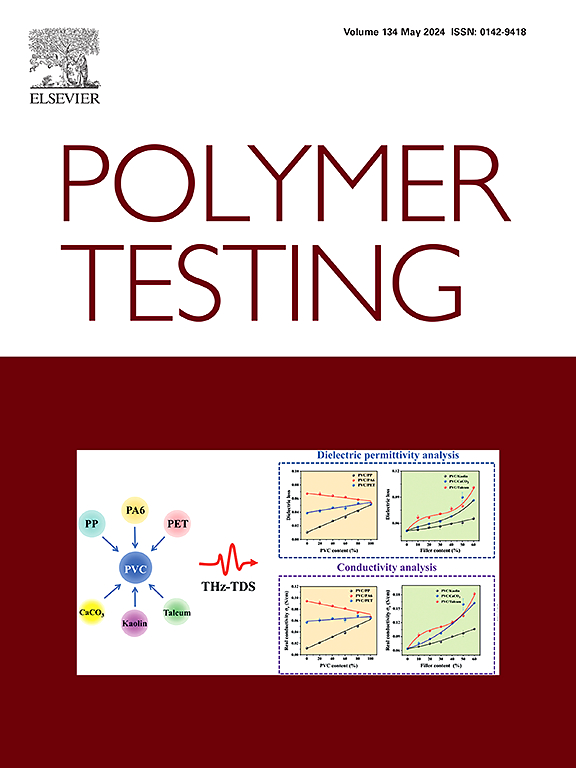Structure and properties of a multilayer composite material for cryogenic applications: From laboratory to industrial scale
IF 6
2区 材料科学
Q1 MATERIALS SCIENCE, CHARACTERIZATION & TESTING
引用次数: 0
Abstract
Glass-epoxy composites are a type of structural material widely used in the aerospace, automotive, wind energetics and construction industries. This study provides a thorough analysis of the mechanical, thermal and electrical properties of a glass-epoxy composite produced under industrial conditions, based on testing at room and cryogenic temperatures. The industrial-scale composite exhibited significantly lower thermal conductivity than the laboratory-prepared sample across the entire temperature range. We attribute this difference to qualitative or quantitative changes in the glass reinforcement. Cyclic loading tests showed only minor degradation of Young's modulus, with values increasing to ∼30–31 GPa under cryogenic conditions. The composite exhibited significant improvements in tensile strength (638 MPa, +54 %), flexural strength (1030 MPa, +87 %), and nearly doubled fracture toughness (42.2 MPa√m), while maintaining comparable impact resistance. These results highlight the excellent mechanical performance and reliability of the material at −196 °C, confirming its suitability for cryogenic applications. This study also evaluates the environmental impact of different composite material manufacturing processes via life cycle assessment (LCA) analysis. The findings suggest that, while the hydraulic press method offers excellent mechanical performance, it has the greatest environmental impact due to its high energy consumption, significant waste generation and contribution to climate change. These results contribute to the development of sustainable composite technologies and may serve as a foundation for further research or for comparing different materials to determine the most suitable option.
低温应用多层复合材料的结构和性能:从实验室到工业规模
玻璃环氧复合材料是一种广泛应用于航空航天、汽车、风能和建筑行业的结构材料。本研究在室温和低温测试的基础上,对工业条件下生产的玻璃环氧复合材料的机械、热学和电学性能进行了全面分析。在整个温度范围内,工业规模的复合材料的导热性明显低于实验室制备的样品。我们将这种差异归因于玻璃增强的定性或定量变化。循环加载试验表明,杨氏模量只有轻微的退化,在低温条件下,杨氏模量增加到~ 30-31 GPa。复合材料在抗拉强度(638 MPa, + 54%)、抗折强度(1030 MPa, + 87%)和断裂韧性(42.2 MPa / m)方面均有显著提高,同时保持了相当的抗冲击性。这些结果突出了该材料在- 196°C下的优异机械性能和可靠性,证实了其适用于低温应用。本研究亦透过生命周期评估(LCA)分析,评估不同复合材料制造工艺对环境的影响。研究结果表明,尽管液压机方法具有优异的机械性能,但由于其高能耗、大量废物产生和对气候变化的贡献,它对环境的影响最大。这些结果有助于可持续复合材料技术的发展,并可作为进一步研究或比较不同材料以确定最合适选择的基础。
本文章由计算机程序翻译,如有差异,请以英文原文为准。
求助全文
约1分钟内获得全文
求助全文
来源期刊

Polymer Testing
工程技术-材料科学:表征与测试
CiteScore
10.70
自引率
5.90%
发文量
328
审稿时长
44 days
期刊介绍:
Polymer Testing focuses on the testing, analysis and characterization of polymer materials, including both synthetic and natural or biobased polymers. Novel testing methods and the testing of novel polymeric materials in bulk, solution and dispersion is covered. In addition, we welcome the submission of the testing of polymeric materials for a wide range of applications and industrial products as well as nanoscale characterization.
The scope includes but is not limited to the following main topics:
Novel testing methods and Chemical analysis
• mechanical, thermal, electrical, chemical, imaging, spectroscopy, scattering and rheology
Physical properties and behaviour of novel polymer systems
• nanoscale properties, morphology, transport properties
Degradation and recycling of polymeric materials when combined with novel testing or characterization methods
• degradation, biodegradation, ageing and fire retardancy
Modelling and Simulation work will be only considered when it is linked to new or previously published experimental results.
 求助内容:
求助内容: 应助结果提醒方式:
应助结果提醒方式:


